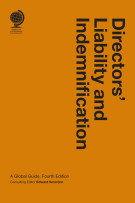
Life Cycle of a Family Business, edited by Barbara R. Hauser, JD, International Family Governance Practitioner and Alon Kaplan, PhD, Advocate, TEP Trust and Estate Practitioner, has been published at a very crucial point in time - in the midst of the corona pandemic, which has proven the vulnerability of both man and his fortune.
Family businesses are no exception, on the contrary, they have always been exposed to certain risks. These risks are on the one hand external ones, for example risks associated to an unstable economy and also internal ones that are linked to the close ties between the family and the business. The lifecycle of family dynasties by some is even believed to follow a declining path, the so-called Buddenbrooks syndrome (K Baus, Die Familienstrategie – wie Familien ihr Unternehmen über Generationen sichern, 2016, 22), coined after the characters in Thomas Mann's novel "Die Buddenbrooks". According to the Buddenbrooks syndrome the father founds and builds up the dynasty, the children sustain the dynasty, and under the grandchildren the dynasty falls apart. Such decline is often triggered by too many family generations being involved in the business and also by the family mistakenly perceiving the business as being the family. The reactions of families to such internal conflicts are also manifold– the worst being not addressing any conflict in the hope that it will disappear all by itself.
The book Life Cycle of a Family Business by analyzing the various stages in the life cycle of a family business identifies both the external and internal risks that a family business is exposed to and aims to counter-steer by providing qualified guidance on how to deal with them when advising an international family owning a family business. It is the outspoken aim of the book to familiarize the reader, ie international families and practitioners alike, with issues that are more often than not unduly neglected in international structuring – namely the issues associated with the family itself, such as for example family leadership succession or divorce. Following this aim the book covers a variety of family-related as well as entrepreneurial questions, thereby also touching on family governance issues, and provides practical insights on how to apply family governance mechanisms to family businesses with a view to risk management and entrepreneurship strategies.
In consequence the book is divided into eight stages, which successfully complement and build on each other, each written by a recognized expert in the field.
Stage I examines the question of enterprise heterogeneity. At the outset Dr. Justin B. Craig makes the reader aware that family businesses, despite appearing very similar on the outside, are actually very different as regards their structure, processes and systems. To gain an understanding why this is so, the very origin of heterogeneity, namely the interrelation between the family and the business is examined and put into context with a view to the different roles of family, owners and managers.
In Stage II Thomas M. Hubler addresses the important issue of emotional family relationships and clarifies that it is the family values that create the culture of the family business. As addressing issues of family relationships is delicate but vital for a family business to move forward, the author by taking this into account offers solutions for developing better family communication strategies, based on equality as well as on a multidisciplinary approach.
In Stage III Dr. Allen Bettis then examines how and especially at which point in time a family should institute a board of directors for its family business and which powers such board should have to achieve continuity and growth of the family business while at the same time implementing the specifications of the owners.
Stage IV deals with risk management and family enterprise expansion. Wendy Sage Hayward takes the reader on the path of the family minimizing risk and sustaining their wealth while addressing and accepting change. The chapter identifies a variety of risk factors that family generations will inevitably face and it offers solutions on how to bring these risks into the open and manage them.
Stage V is yet another core chapter in the book as it deals with the protection of the family business in divorce proceedings. Claire Gordon and Daisy Tarnowska, by focusing on one specific jurisdiction, England and Wales, show how a family business may suffer from the division of assets upon divorce. Referring to case studies they propose solutions to minimize the negative effects of asset separation on the family business while at the same time acknowledging the positions of the divorcees and their family.
Stage VI deals with the question on how to anticipate, prepare for and adapt to change in an era of unprecedented turbulence while at the same time making the family business more resilient for the long term. Professor Peter Vogel stresses entrepreneurship as the key for a successful tomorrow of family businesses and lays out the possibilities of supporting traditional entrepreneurial activity within a family business, of investing in external startups or of even gradually transforming the businesses into entrepreneurial ecosystems.
Christian Stewart in Stage VII returns to the question of leadership succession in family businesses and in doing so also to the question whether to continue to run a family business by family members also in future generations, or alternatively to revert to external managers. After all, family members in running and thereby sustaining a family business must according to objective criteria be fit and able to do so. Stage VII thus addresses the corresponding family governance issues in this respect and shows the way forward for intra-family and also inter-generational planning in order to meet the challenges of keeping the family business on track.
The concluding Stage VIII, written by Dr. Dennis T. Jaffe, examines the condition of the family business beyond the third generation. Its success will depend on whether both family and business have moved across the generations, and this both in terms of business and family. There are common challenges to every family business and each new generation of family members to follow into the business, but those can only be tackled if the family and the business are conceived as two separate, but yet intertwined pillars.
Practitioners as well as families owning a family business will benefit from this book as it fills a prevalent vacuum in addressing and advising on vital family and business related questions, questions that are crucial to sustaining any family business. The accomplished authors all contribute detailed explanations to these questions as well as examples, case studies and graphs that help to combine factual information with practical considerations in the general context of the subject.
The holistic discussion and the detail with which the reader is familiarized will certainly stimulate further thought and develop a greater understanding of the workings of family businesses worldwide. As such the book is also an ideal starting point with a view to any corporate structuring for international families, both in the pre- as well as the later structuring phases. Change is inherent to any planning, be it for a family or for a business. But as Life Cycle of a Family Business convincingly shows, the sooner it is addressed, the better it can be accommodated.
,





